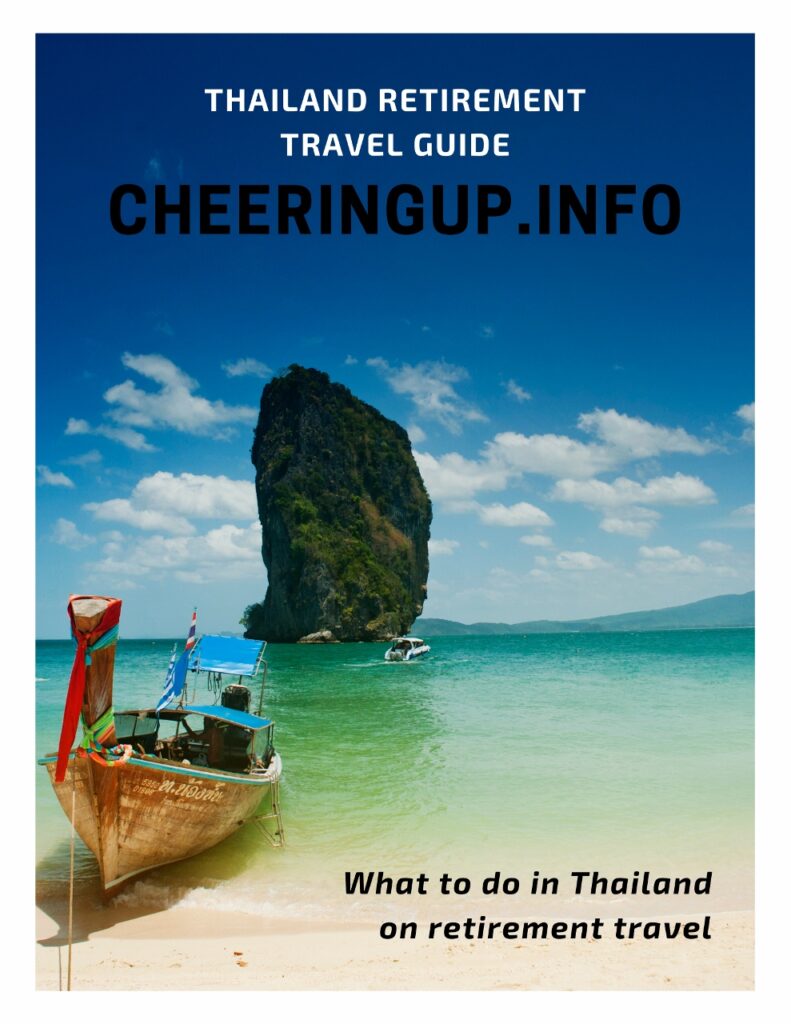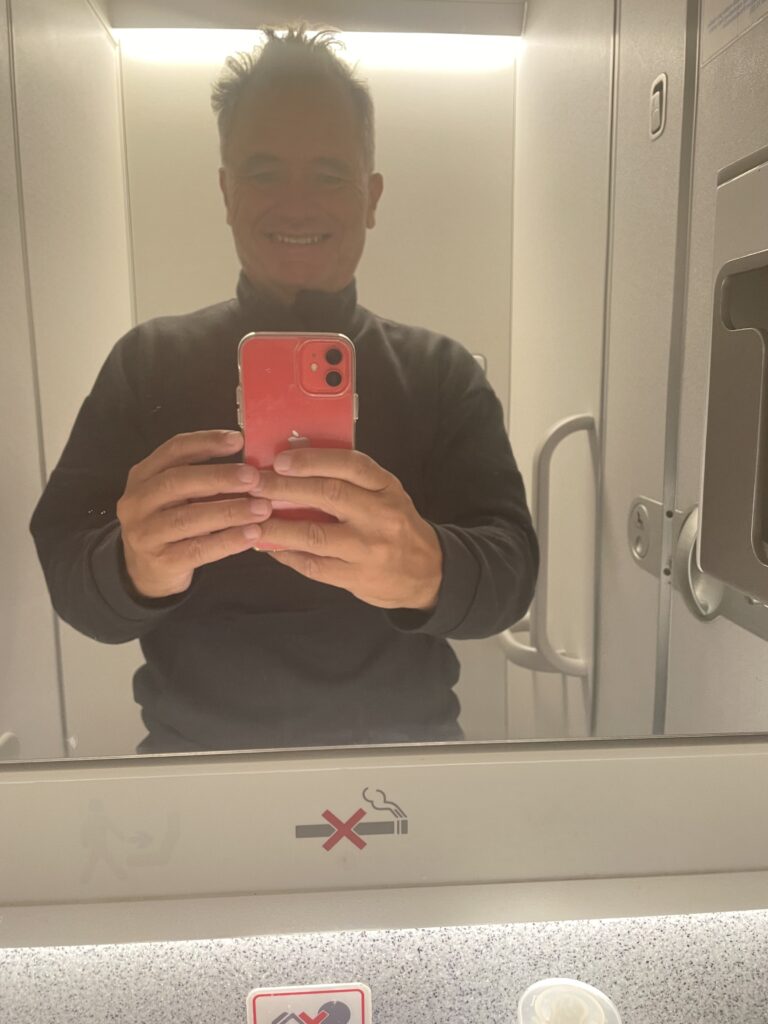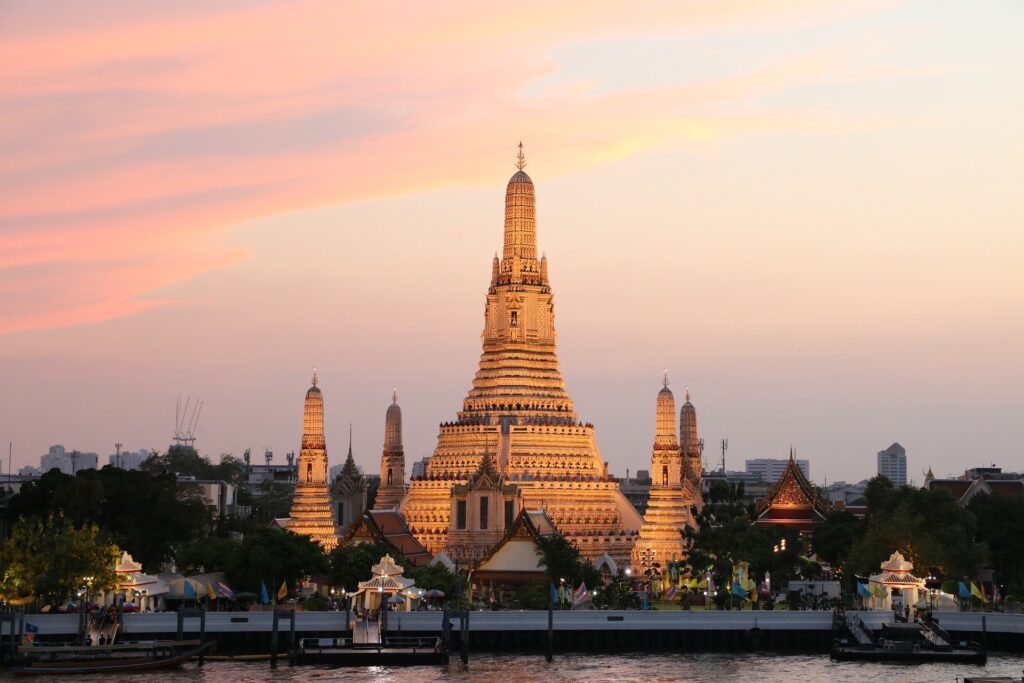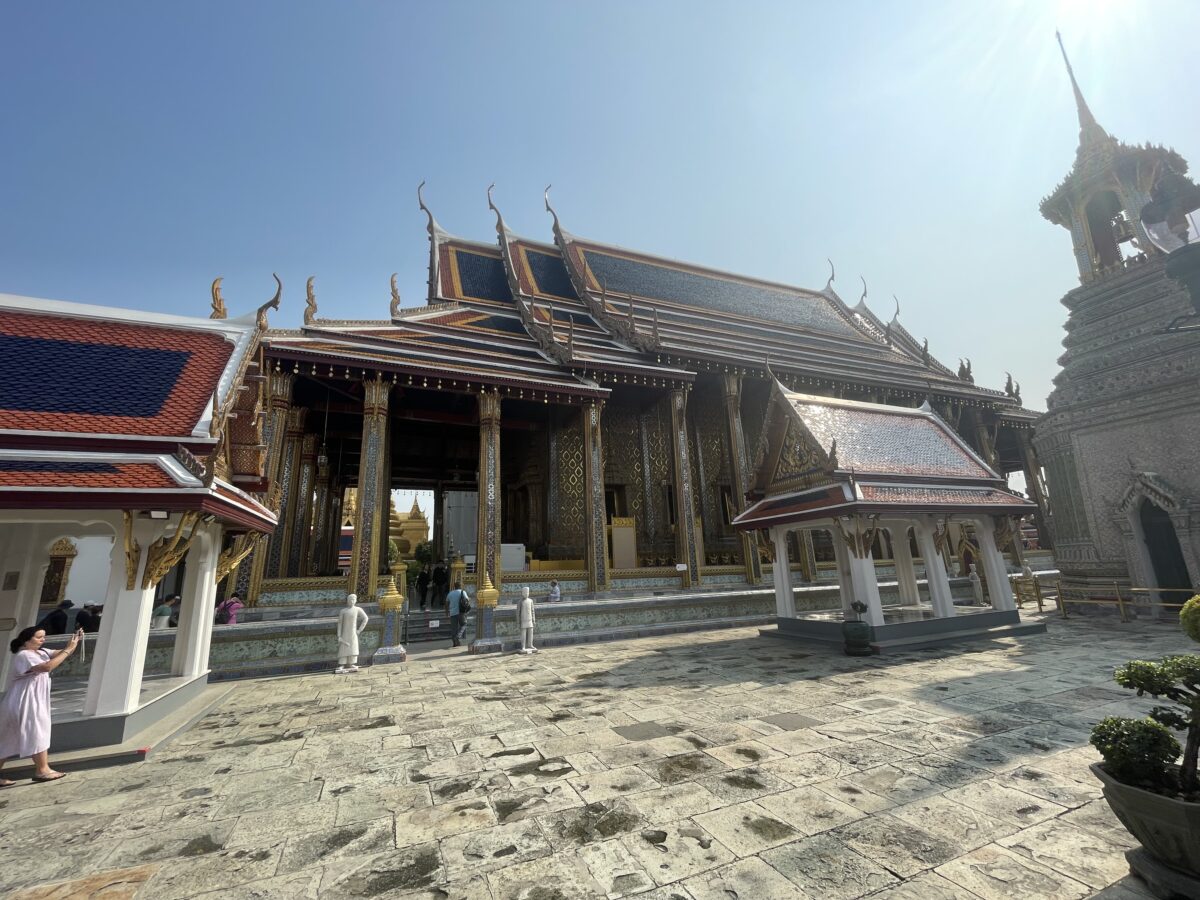Exploring the best of Thailand
See the beauty of Thailand online starting from Brazil!

Join our Retirement Club today for lifetime membership!

The Grand Palace
The Grand Palace is a sprawling complex of buildings at the heart of Bangkok, Thailand. It served as the official residence of the Kings of Siam (later Thailand) from 1782 until 1925. Today, the Grand Palace remains a symbol of the Thai monarchy and a major tourist attraction.
Why It’s Worth Visiting:
- Historical Significance: The Grand Palace has been the centre of Thai royalty for centuries. It played a crucial role in the history and development of Bangkok and Thailand.
- Architectural Splendor: The complex showcases a blend of traditional Thai and European architectural styles. Its intricate details, gilded facades, and exquisite craftsmanship are breathtaking.
- Emerald Buddha: Within the Grand Palace grounds is Wat Phra Kaew (Temple of the Emerald Buddha), which houses the revered Emerald Buddha, a statue carved from a single block of jade.
- Cultural Insight: Visiting the Grand Palace offers a deep dive into Thai culture, religion, and art. It’s a place where you can observe the traditions and reverence the Thai people have for their monarchy and religion.
- Gardens and Courtyards: The Palace grounds include beautifully manicured gardens and courtyards, providing a serene environment amid the bustling city.
Tips and Secrets for Making the Most of Your Visit:
- Dress Code: Strict dress code enforcement requires visitors to wear modest clothing. Shoulders and knees must be covered. Avoid ripped jeans, leggings, or see-through clothing. Sarongs are available for rent at the entrance if needed.
- Best Time to Visit: Arrive early in the morning to avoid the crowds and the midday heat. The palace opens at 8:30 AM, and being there at opening time can enhance your experience.
- Plan Your Visit: Allocate at least 2-3 hours to explore the complex fully. The grounds are extensive, and there’s much to see.
- Guided Tours: Consider hiring a guide or joining a guided tour. Knowledgeable guides can provide detailed explanations about the history, architecture, and significance of the various buildings and statues.
- Avoid Scams: Be wary of touts outside the palace who may tell you that it’s closed for a private event and offer alternative tours. The palace is rarely closed to the public.
- Photography: While photography is allowed in many parts of the Grand Palace, it is prohibited inside the Temple of the Emerald Buddha. Be respectful and follow the rules.
- Stay Hydrated: Bangkok can be very hot and humid. Bring water and stay hydrated during your visit.
- Visit Nearby Attractions: Combine your visit with nearby attractions like Wat Pho (Temple of the Reclining Buddha) and Wat Arun, which are a short boat ride away across the Chao Phraya River.
- Entrance Fee: Be prepared to pay an entrance fee. As of my last update, it was 500 Thai Baht. Check for the latest prices and payment options.
Secret Tips:
- Hidden Gems: Look for the miniature model of Angkor Wat, which is tucked away in the northeastern corner of the palace complex. It’s an often-overlooked but fascinating replica.
- Museum of the Emerald Buddha Temple: This museum within the complex is less crowded and contains interesting artifacts related to the Emerald Buddha and the Grand Palace.
- Quiet Spots: If you need a break from the crowds, head to the quieter gardens and courtyards within the complex. They offer a peaceful retreat and beautiful photo opportunities.
Visiting the Grand Palace is a highlight of any trip to Bangkok, providing a rich historical and cultural experience. With these tips, you can ensure a smooth and memorable visit.
Temple of the Emerald Buddha
Known as Wat Phra Kaew (Wat Phra Sri Rattana Satsadaram), is located within the Grand Palace complex in Bangkok, Thailand. This temple is one of the most important and revered Buddhist temples in Thailand, housing the highly venerated Emerald Buddha statue.
Key Highlights of Wat Phra Kaew:
- Emerald Buddha: The statue itself is carved from a single block of jade (not emerald, despite the name) and is considered the palladium of Thailand. It is believed to have miraculous powers and is a symbol of the Thai state.
- Royal Robes: The Emerald Buddha is adorned with seasonal costumes, which are changed three times a year by the King of Thailand during a special ceremony to mark the changing seasons (summer, rainy season, and winter).
- Architectural Beauty: Wat Phra Kaew is renowned for its stunning architecture and intricate detail. The temple is adorned with gold leaf, mosaics, and murals depicting various scenes from Buddhist mythology.
- Murals and Art: The inner walls of the temple complex are covered with murals depicting the Ramakien, the Thai version of the Indian epic Ramayana.
Tips for Visiting Wat Phra Kaew within the Grand Palace:
- Strict Dress Code: As with the rest of the Grand Palace, Wat Phra Kaew has a strict dress code. Ensure you are dressed modestly, with shoulders and knees covered.
- Respect the Rules: Photography is not allowed inside the main temple building where the Emerald Buddha is housed. Be respectful and follow all guidelines.
- Best Time to Visit: Early morning visits are ideal to avoid the crowds and heat. The temple and palace complex open at 8:30 AM.
- Explore the Entire Complex: Besides the Emerald Buddha, the Wat Phra Kaew complex includes several other important buildings and statues worth exploring. Take your time to walk around and appreciate the detailed artistry.
By visiting Wat Phra Kaew, you get to experience one of the most sacred sites in Thailand and witness the cultural and spiritual heritage that it embodies.
Wat Pho (Temple of the Reclining Buddha)
Wat Arun Ratchawararam Ratchawaramahawihan

Commonly known as Wat Arun or the Temple of Dawn, is one of Bangkok’s most famous landmarks. This Buddhist temple is situated on the Thonburi west bank of the Chao Phraya River and is renowned for its stunning architecture and riverside location.
Why It’s Worth Visiting:
- Wat Arun is famous for its central prang (tower) which is encrusted with colourful porcelain and seashells. This central spire is surrounded by four smaller towers and represents Mount Meru, the centre of the universe in Buddhist cosmology.
- The temple dates back to the Ayutthaya period and has a rich history intertwined with the history of Bangkok and Thailand. It was named after Aruna, the Indian God of Dawn, and has been a significant spiritual site for centuries.
- The temple offers breathtaking views, especially at sunrise and sunset. Climbing the central prang provides panoramic vistas of the Chao Phraya River and the surrounding cityscape.
- Visiting Wat Arun provides insight into Thai culture and Buddhism. The intricate designs and statues, including depictions of the Buddha’s life, offer a glimpse into traditional Thai art and religious practices.
How to Make the Most of Your Visit:
- Early morning or late afternoon are the best times to visit to avoid the heat and crowds. Sunset visits are particularly beautiful as the temple is illuminated.
- As a place of worship, visitors should dress modestly. Wear clothes that cover your shoulders and knees.
- Take time to explore the various structures within the temple complex, including the central prang, the ordination hall, and the pavilions.
- Consider hiring a guide or using an audio guide to learn more about the temple’s history, significance, and architectural details.
- Don’t forget your camera. The temple’s intricate details and the scenic river backdrop offer excellent photo opportunities.
- Arriving or departing by boat adds to the experience, providing a picturesque view of the temple from the river.
- Be mindful of local customs and rules. Keep your voice low, don’t touch religious artifacts, and be respectful of those who are there to worship.
Wat Arun is not just a visual marvel but a deep cultural and spiritual experience, making it a must-visit when in Bangkok.
What are the taxes in Thailand?
In Thailand, the tax system includes various types of taxes for individuals and businesses. Here is an overview:
Individual Income Tax
- Residents: Individuals who reside in Thailand for 180 days or more within a calendar year are subject to personal income tax on their worldwide income.
- Non-residents: Individuals who stay less than 180 days are taxed only on income sourced within Thailand.
Tax Rates:
- 0% for income up to THB 150,000
- 5% for income from THB 150,001 to THB 300,000
- 10% for income from THB 300,001 to THB 500,000
- 15% for income from THB 500,001 to THB 750,000
- 20% for income from THB 750,001 to THB 1,000,000
- 25% for income from THB 1,000,001 to THB 2,000,000
- 30% for income from THB 2,000,001 to THB 5,000,000
- 35% for income over THB 5,000,000
Corporate Income Tax
- Standard Rate: 20% on net profits.
- Small and Medium Enterprises (SMEs): Reduced rates are available based on profit thresholds.
Value Added Tax (VAT)
- Standard Rate: 7%
- Certain goods and services are exempt, such as agricultural products, educational services, and healthcare services.
Specific Business Tax (SBT)
- Applies to certain businesses like banking and real estate.
- Rates vary depending on the type of business, generally ranging from 0.1% to 3%.
Withholding Tax
- Applied to various payments including dividends, interest, royalties, and service fees.
- Rates vary:
- Dividends: 10%
- Interest: 15%
- Royalties: 15%
- Service fees: 3% (for domestic) and 5% (for international).
Property Tax
- Land and Building Tax: Implemented in 2020, it taxes land and buildings based on their usage (residential, agricultural, commercial, or unused). Rates range from 0.01% to 0.7%.
- Transfer Fee: 2% of the appraised value.
- Specific Business Tax (on property transfer): 3.3% if applicable.
Other Taxes
- Excise Tax: Applied to specific goods such as alcohol, tobacco, and fuel.
- Stamp Duty: Levied on certain legal documents and transactions.
Tax Incentives
Thailand offers various tax incentives through the Board of Investment (BOI), including tax holidays and exemptions to promote investment in targeted sectors.
These rates and regulations are subject to change, so it’s advisable to consult with a tax professional or the Revenue Department of Thailand for the most current information.
